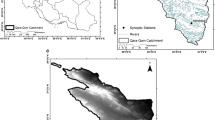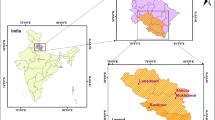Abstract
The quality and completeness of rainfall data is a critical aspect in time series analysis and for the prediction of future water-related disasters. An accurate estimation of missing data is essential for better rainfall prediction results. This study suggests a novel approach for estimating missing rainfall data using Multilayer Perceptron (MLP) neural networks based on three configurations that are represented by the monsoon season (MS), non-monsoon season (NMS), and non-seasonal variation. For this purpose, first, the rainfall dataset was transformed by the wavelet transform method and then, a mathematical model was created to analyze and predict the transformed data in Seoul, South Korea. Missing rainfall data in three time periods from Seoul station were reconstructed using the transformed rainfall data of the other five stations (e.g., Guroguchung, Daegokgyo, Songjeongden, Dongmakgoljuchajang, and Wallgaegyo). The results showed that using the Coiflet wavelet transform with MLP model (named Coi_MLP) estimated missing data more accurately, which is obtained from the results of statistical criteria including root mean square error, mean absolute error, and correlation coefficient of 1.18, 0.49, and 0.99 for transformed MS data and 0.76, 0.18, and 0.99 for transformed NMS data, respectively. The Coi_MLP model can effectively perform rainfall data reconstruction and predict missing rainfall data accurately, especially when the length of the statistical period is limited to the MS and NMS with different volumes of rainfall.





Similar content being viewed by others
Data availability
Data can be found at the link https://wamis.go.kr.
Change history
16 January 2024
A Correction to this paper has been published: https://doi.org/10.1007/s00477-023-02574-2
References
Abadi M, Agarwal A, Barham P, Brevdo E, Chen Z, Citro C, Corrado GS, Davis A, Dean J, Devin M, Ghemawat S, Goodfellow I, Harp A, Irving G, Isard M, Jia Y, Jozefowicz R, Kaiser L, Kudlur M, Levenberg J, Mane D, Monga R, Moore sh, Murray D, Olah Ch, Schuster M, Shlens J, Steiner B, Sutskever I, Talwar K, Tucker P, Vanhoucke V, Vasudevan V, Viegas F, Vinyals O, Warden P, Wattenberg M, Wicke M, Yu Y, Zheng X (2016) TensorFlow: Large- 20 Scale Machine Learning on Heterogeneous Distributed Systems. https://doi.org/10.48550/arXiv.1603.04467
Abdel-Kader H, Abd-Elsalam M, Mohamed M (2021) Hybrid machine learning model for rainfall forecasting. J Intell Syst Internet Things 1:5–12. https://doi.org/10.5281/zenodo.3376685
Abhishek K, Kumar A, Ranjan R, Kumar S (2012) A rainfall prediction model using artificial neural network. IEEE Control Syst Grad Res Colloq 82–87. https://doi.org/10.1109/ICSGRC.2012.6287140
Adamowski J, Sun K (2010) Development of a coupled wavelet transform and neural network method for flow forecasting of non-perennial rivers in semi-arid watersheds. J Hydrol 390(1–2):85–91. https://doi.org/10.1016/j.jhydrol.2010.06.033
Akiner ME (2021) Long-term rainfall information forecast by utilizing constrained amount of observation through artificial neural network approach. Adv Meteorol 1–9. https://doi.org/10.1155/2021/5524611
Atiquzzaman M, Kandasamy J (2016) Prediction of hydrological time-series using extreme learning machine. J Hydroinf 18:345–353. https://doi.org/10.2166/hydro.2015.020
Brimicombe A (2003) GIS, Environmental Modelling and Engineering, first ed. Taylor & Francis, London
Chollet F (2015) Keras: deep learning for humans. GitHub repository
Coulibaly P, Evora ND (2007) Comparison of neural network methods for infilling missing daily weather records. J Hydrol 341:27–41. https://doi.org/10.1016/j.jhydrol.2007.04.020
Creutin JD, Andrieu H, Faure D (1997) Use of a weather radar for the hydrology of a mountainous area. Part II: radar measurement validation. J Hydrol 193(1–4):26–44. https://doi.org/10.1016/S0022-1694(96)03203-9
Daubechies I (1992) Ten Lectures on Wavelets; Society for Industrial and Applied Mathematics (Siam): Philadelphia, PA, USA; Volume 61
Deo RC, Samui P (2017) Forecasting evaporative loss by least-square support-vector regression and evaluation with genetic programming, gaussian process, and minimax probability machine regression: case study of Brisbane City. J Hydrol Eng 22(6):05017003. https://doi.org/10.1061/(ASCE)HE.1943-5584.0001506
Dos Santos EP, Dias RLS, Maciel IP, Kolling Neto A, da Silva DD (2021) Environ Earth Sci 80:1–9. https://doi.org/10.1007/s12665-021-09409-9. Estimation of missing hydrological data in monthly rainfall series using meteorological satellite data
Eischeid JK, Pasteris PA, Diaz HF, Plantico MS, Lott NJ (2000) Creating a serially complete, national daily time series of temperature and precipitation for the western United States. J Appl Meteor and Clim 39(9):1580–1591. https://doi.org/10.1175/1520-0450(2000)039<1580:CASCND>2.0.CO;2
Ekeu-wei IT, Blackburn GA, Pedruco P (2018) Infilling missing data in hydrology: solutions using satellite radar altimetry and multiple imputation for data-sparse regions. Water 10(10):1483. https://doi.org/10.3390/w10101483
El Houari MB, Zegaoui O, Abdallaoui A (2015) Prediction of air temperature using multi-layer perceptions with Levenberg-Marquardt training algorithm. Int. Res. J. Eng. Technol. (IRJET). 2. http://www.irjet.net
Gizaw MS, Gan TY (2016) Regional Flood frequency analysis using support Vector Regression under historical and future climate. J Hydrol 538:387–398. https://doi.org/10.1016/j.jhydrol.2016.04.041
Grayson R, Blöschl G (2001) Spatial patterns in Catchment Hydrology: observations and modelling. CUP Archive
Hastie T, Tibshirani R, Friedman JH (2009) The elements of statistical learning: data mining, inference, and prediction. Springer Science and Business Media
Hernández E, Sanchez-Anguix V, Julian V, Palanca J, Duque N (2016) Rainfall prediction: A deep learning approach. Lecture Notes in Computer Science. International Conference on Hybrid Artificial Intelligence Systems, Springer, Cham. 151–162. https://doi.org/10.1007/978-3-319-32034-2_13
Hong S, Yang H, Zio E, Huang N (2014a) A novel dynamics model of fault propagation and equilibrium analysis in complex dynamical communication network. Appl Math Comput 247:1021–1029. https://doi.org/10.1016/j.amc.2014a.09.029
Hong S, Zhou Z, Zio E, Hong K (2014b) Condition assessment for the performance degradation of bearing based on a combinatorial feature extraction method. Digit Signal Process 27:159–166. https://doi.org/10.1016/j.dsp.2013.12.010
Hu MJC (1964) Application of the Adaline System to Weather Forecasting (Doctoral dissertation, Department of Electrical Engineering, Stanford University)
Kalogirou SA, Neocleous C, Michaelides S (1997) A time series reconstruction of precipitation records using artificial neural networks. https://ktisis.cut.ac.cy/handle/10488/18156
Khan MI, Maity R (2020) Hybrid deep learning approach for multi-step-ahead daily rainfall prediction using GCM simulations. IEEE Access 8:52774–52784. https://doi.org/10.1109/ACCESS.2020.2980977
Kingma DP, Ba J (2014) Adam: a method for stochastic optimization. arXiv Preprint ArXiv:1412.6980
LeCun Y, Bengio Y, Hinton G (2015) Deep Learn Nat 521:436–444. https://doi.org/10.1038/nature14539
Lee S, Kim JC, Jung HS, Lee MJ, Lee S (2017) Spatial prediction of flood susceptibility using random-forest and boosted-tree models in Seoul metropolitan city. Korea Geom Nat Hazards Risk 8:1185–1203. https://doi.org/10.1080/19475705.2017.1308971
Luk KC, Ball JE, Sharma A (2000) A study of optimal model lag and spatial inputs to artificial neural network for rainfall forecasting. J Hydrol 227:56–65. https://doi.org/10.1016/S0022-1694(99)00165-1
Lynch SD (2003) Development of a raster database of annual, monthly and daily rainfall for Southern Africa. p. 78. WRC Report N 1156/1/03.
Makhuvha T, Pegram G, Sparks R, Zucchini W (1997) Best subset selection, EM and pseudo-EM methods: theory. J Hydrol 198(1–4):289–307. https://doi.org/10.1016/S0022-1694(96)03285-4. Patching rainfall data using regression methods.: 1
Michaelides SC, Neocleous CC, Schizas CN (1995) Artificial neural networks and multiple linear regression in estimating missing rainfall data. In proceedings of the DSP95 International Conference on Digital Signal Processing, Limassol, Cyprus. 668–673
Narimani R, Jun C, Saedi A, Bateni SM, Oh J (2022) A multivariate decomposition-ensemble model for estimating long-term rainfall dynamics. Clim Dyn. https://doi.org/10.1007/s00382-022-06646-x
Nastos PT, Paliatsos AG, Koukouletsos KV, Larissi IK, Moustris KP (2014) Artificial neural networks modeling for forecasting the maximum daily total precipitation at Athens. Greece Atmos Res 144:141–150. https://doi.org/10.1016/j.atmosres.2013.11.013
O’Sullivan D, Unwin DJ (2010) Geogr Inf Anal 1–32. https://doi.org/10.1002/9780470549094.ch1. Geographic information analysis and spatial data
Phoeurn C, Ly S (2018) Assessment of satellite rainfall estimates as a pre-analysis for water environment analytical tools: a case study for Tonle Sap Lake. in Cambodia Eng J 22(1):229–241. https://doi.org/10.4186/ej.2018.22.1.229
Praveen B, Talukdar S, Mahato S, Mondal J, Sharma P, Islam ARMT, Rahman A (2020) Analyzing trend and forecasting of rainfall changes in India using non-parametrical and machine learning approaches. Sci Rep 10(1):1–21. https://doi.org/10.1038/s41598-020-67228-7
Ramachandran P, Zoph B, Le QV (2017) Searching for activation functions. arXiv Preprint ArXiv:1710.05941
Reinoso PLG (2015) Ingeniare 18:73–86. https://doi.org/10.18041/1909-2458/ingeniare.18.539. Imputación de datos en series de precipitación diaria caso de studio cuenca del río Quindío
Rhif M, Ben Abbes A, Farah IR, Martínez B, Sang Y (2019) Wavelet transform application for/in non-stationary time-series analysis: a review. Appl Sci 9(7):1345. https://doi.org/10.3390/app9071345
Rosenblatt F (1961) Principles of neurodynamics, perceptrons and the theory of brain mechanisms. Cornell Aeronautical Laboratory Inc., Buffalo New York
Sainath TN, Kingsbury B, Saon G, Soltau H, Mohamed AR, Dahl G, Ramabhadran B (2015) Deep convolutional neural networks for large-scale speech tasks. Neural Netw 64:39–48. https://doi.org/10.1016/j.neunet.2014.08.005
Samadianfard S, Majnooni-Heris A, Qasem SN, Kisi O, Shamshirband S, Chau KW (2019) Daily global solar radiation modeling using data-driven techniques and empirical equations in a semi-arid climate. Eng Appl Comp Fluid Mech 13(1):142–157. https://doi.org/10.1080/19942060.2018.1560364
Sang YF (2013) Improved wavelet modeling framework for hydrologic time series forecasting. Water Resour Manag 27(8):2807–2821. https://doi.org/10.1007/s11269-013-0316-1
Simanton JR, Osborn HB (1980) Reciprocal-distance estimate of point rainfall. J Hydr Div 106(7):1242–1246. https://doi.org/10.1061/JYCEAJ.0005466
Singh V, Xiaosheng Q (2019) Clim Dyn 53(5–6):3289–3313. https://doi.org/10.1007/s00382-019-04703-6. Data assimilation for constructing long-term gridded daily rainfall time series over Southeast Asia
Teegavarapu RSV (2007) Use of universal function approximation in variance-dependent surface interpolation method: an application in hydrology. J Hydrol 332(1–2):16–29. https://doi.org/10.1016/j.jhydrol.2006.06.017
Teegavarapu RSV, Tufail M, Ormsbee L (2009) Optimal functional forms for estimation of missing precipitation data. J Hydrol 374(1–2):106–115. https://doi.org/10.1016/j.jhydrol.2009.06.014
Vieux BE (2001) Distributed hydrologic modeling using GIS. Distributed hydrologic modeling using GIS. Water Science and Technology Library. Springer, Dordrecht, pp 1–17. https://doi.org/10.1007/978-94-015-9710-4_1.
Wang B (2002) Rainy season of the asian–pacific summer monsoon. J Clim 15(4):386–398
Wang D, Lu WZ (2006) Forecasting of ozone level in time series using MLP model with a novel hybrid training algorithm. Atmos Environ 40(5):913–924. https://doi.org/10.1016/j.atmosenv.2005.10.042
Wang B, Jhun JG, Moon BK (2007) Variability and singularity of Seoul, South Korea, rainy season (1778–2004). J Clim 20:2572–2580. https://doi.org/10.1175/JCLI4123.1
Willmott CJ, Robeson SM, Feddema JJ (1994) Estimating continental and terrestrial precipitation averages from rain-gauge networks. Int J Climatol 14(4):403–414. https://doi.org/10.1002/joc.3370140405
Wu D, Wang J, Teng Y (2004) Prediction of under-ground water levels using wavelet decompositions and transforms. J Hydrol Eng 5:34–39
Xia Y, Fabian P, Stohl A, Winterhalter M (1999) Forest climatology: estimation of missing values for Bavaria. Ger Agric For Meteorol 96:131–144. https://doi.org/10.1016/S0168-1923(99)00056-8
Yen MH, Liu DW, Hsin YC, Lin CE, Chen CC (2019) Application of the deep learning for the prediction of rainfall in Southern Taiwan. Sci Rep 9(1):12774. https://doi.org/10.1038/s41598-019-49242-6
Zou J, Han Y, So SS (2008) Overview of artificial neural networks. Methods Mol Biol 458:15–23. https://doi.org/10.1007/978-1-60327-101-1_2
Funding
This work was supported by the Korea Meteorological Administration Research and Development Program under Grant [KMI2022-01910] and in part by the Chung-Ang University Research Grants in 2021.
Author information
Authors and Affiliations
Corresponding author
Ethics declarations
Conflict of interest
The authors declare that they have no known competing financial interests or personal relationships that could have appeared to influence the work reported in this paper.
Additional information
Publisher’s Note
Springer Nature remains neutral with regard to jurisdictional claims in published maps and institutional affiliations.
The original online version of this article was revised due to funding information correction.
Electronic Supplementary Material
Below is the link to the electronic supplementary material.
Rights and permissions
Springer Nature or its licensor (e.g. a society or other partner) holds exclusive rights to this article under a publishing agreement with the author(s) or other rightsholder(s); author self-archiving of the accepted manuscript version of this article is solely governed by the terms of such publishing agreement and applicable law.
About this article
Cite this article
Narimani, R., Jun, C., De Michele, C. et al. Multilayer perceptron-based predictive model using wavelet transform for the reconstruction of missing rainfall data. Stoch Environ Res Risk Assess 37, 2791–2802 (2023). https://doi.org/10.1007/s00477-023-02471-8
Accepted:
Published:
Issue Date:
DOI: https://doi.org/10.1007/s00477-023-02471-8




